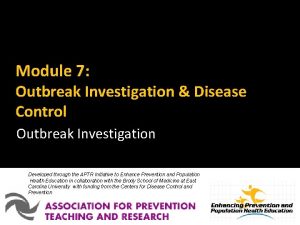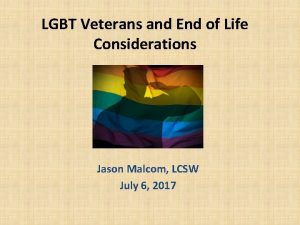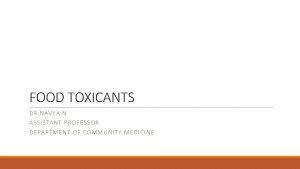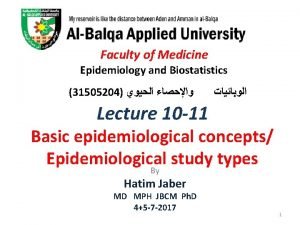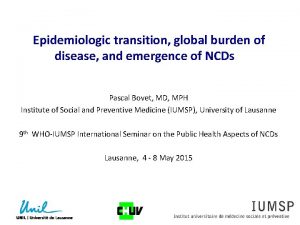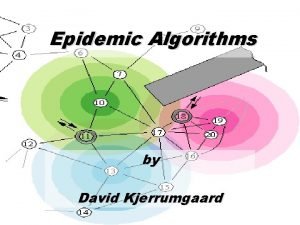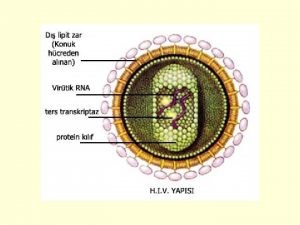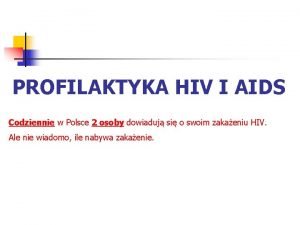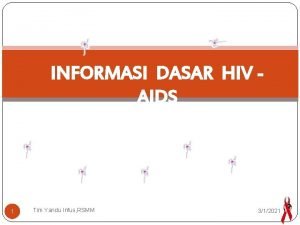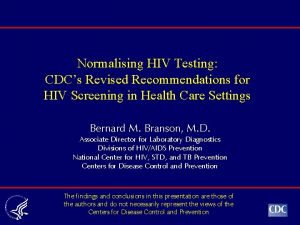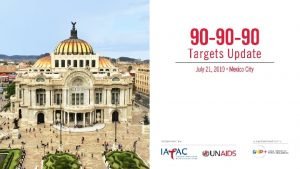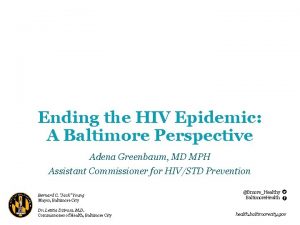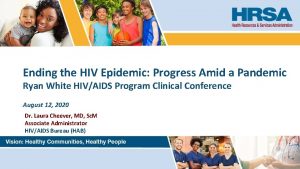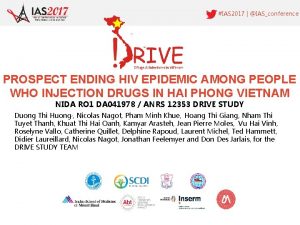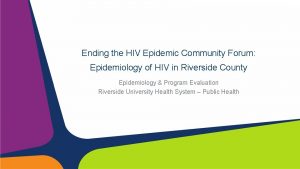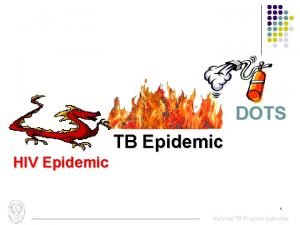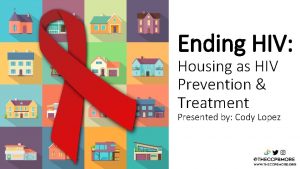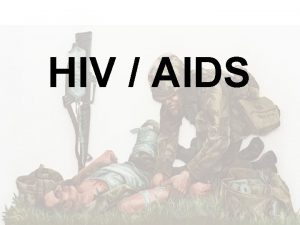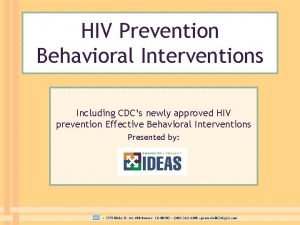CDCs Role in Ending the HIV Epidemic Eugene















- Slides: 15

CDC’s Role in Ending the HIV Epidemic Eugene Mc. Cray, MD Director, Division of HIV/AIDS Prevention August 12, 2020

Outline § CDC’s role in EHE § EHE Key Activities

Diagnose Strategies 1 Apply innovative approaches to increase testing in clinical settings 2 Develop systems to make HIV testing more accessible in non-traditional settings (e. g. jails) 3 Establish ways to regularly re-screen people at increased risk Outcomes Increase Knowledge of HIV Status Reduce New HIV Diagnoses

Treat Strategies 1 2 Ensure rapid linkage to HIV medical care and antiretroviral therapy (ART) initiation for all persons with newly diagnosed with HIV Support re-engagement and retention in HIV medical care and treatment adherence, especially for persons who are not recipients of Ryan White HIV/AIDS Programs Outcomes Increase receipt of HIV Medical Care among Persons with HIV Increase Viral Suppression Among Persons Living with Diagnosed HIV

Prevent Strategies 1 2 Accelerate efforts to increase pre-exposure prophylaxis (Pr. EP) use, particularly for populations with the highest rates of new HIV diagnoses and low Pr. EP use among those with indications for Pr. EP Increase availability, use, and access to and quality of comprehensive syringe services programs (SSPs) Outcomes Increased Pr. EP prescriptions among Increased knowledge about the Increased quality of evidencepersons with indications for Pr. EP services and evidence base of SSPs in based SSP service delivery communities

Respond Strategies 1 Develop partnerships, processes, data systems, and policies to facilitate robust, real-time cluster detection and response 2 Investigate and intervene in networks with active transmission 3 Identify and address gaps in programs and services revealed by cluster detection and response Outcome Improved response to HIV transmission clusters and outbreaks

Expanding the HIV Workforce Expanding the capacity of the HIV workforce across the United States is essential in ending the HIV epidemic. In October 2019, CDC hired 10 Public Health Field Assignees to increase the HIV workforce capacity in the health departments of several EHE jurisdictions, including: • • • Arizona Baltimore City, Maryland Georgia Houston, Texas Los Angeles, California • • • Michigan New Jersey Philadelphia, Pennsylvania Tennessee Washington, D. C. CDC will continue to work with health departments and leverage programs, such as PHAP in 2020.

CDC’s Key Activities

Ending the HIV Epidemic 2019 & 2020 CDC Activities and Funding Overview Summer 2019 Jumpstart Sites $4. 5 Million Fall 2019 Strategic Community Planning $12 Million Summer 2020 Implementation $140 Million

From July 2019 to June 2020, Jumpstart Sites Laid the Foundation for Advancing EHE Goals Nationwide Baltimore City, MD De. Kalb County, GA § Incorporated HIV/STD testing into a mobile syringe-services program. § Initiated a jail-based HIV testing program and trained nurses to deliver HIV testing in in the De. Kalb County Jail. § Implemented a care navigation and treatment program to improve viral suppression in two clinics. § Provided access to Pr. EP in two health centers. § Implemented home-based HIV self-testing and STI testing via the internet. § Provided same-day linkage to care and treatment for those newly diagnosed during targeted outreach testing. § Provided access to Pr. EP through an innovative program where registered nurses can order Pr. EP through a delegated agreement with a local physician. East Baton Rouge, LA § Established HIV and hepatitis testing in an emergency department. § Increased the HIV testing capacity of 5 community-based organizations. § Hired five community health workers and two rapid-start navigators to reach out to the communities most impacted by the epidemic.

EHE Strategic Community Planning In September 2019, CDC awarded $12 million from HHS’ Minority HIV/AIDS Fund to the 32 eligible state and local health departments that represent all of the EHE Phase 1 Jurisdictions Local EHE Planning • Jurisdictions engaged local partners and community members to develop community-tailored EHE plans EHE Planning Assistance • NASTAD (National Alliance of State and Territorial AIDS Directors) received $1. 5 million to provide capacity building assistance and support jurisdictional planning through its robust partnership system

Ending the HIV Epidemic: Jurisdictional planning efforts Jumpstart Sites • Received draft EHE plans from all jurisdictions and provided feedback in the Spring EHE Planning • Jurisdictions are working on revising plans • Revised EHE plans are now due on December 31, 2020 • No cost extension provided for grantees Implementation Activities

EHE Implementation 2020 In August 2020, CDC awarded $109 million in funding for EHE Phase 1 Jurisdictions to implement disruptively innovative HIV prevention strategies. Treat Diagnose Treat people with HIV rapidly and effectively to reach sustained viral suppression. Diagnose all people with HIV as early as possible. 90% Reduction in New HIV Infections by 2030 Prevent new HIV transmissions by using proven interventions, including pre-exposure prophylaxis (Pr. EP) & syringe services programs (SSPs) Respond quickly to potential HIV outbreaks to get needed prevention and treatment services to people who need them.

COVID-19 and EHE § EHE remains high priority during COVID-19 pandemic § Efforts to mitigate COVID-19 Impact – Allowing flexible grants management/reporting – Providing guidance and sharing lessons learned from the field • HIV self-testing • Implementing syringe service programs during COVID-19 • Providing Pr. EP when facility-based and in-person patient-clinician contact limited – Working with local surveillance and program staff to set priorities • Delaying labor intensive activities • Limiting reporting to core data elements

Thank You. www. cdc. gov/End. HIV
 Endemic epidemic
Endemic epidemic Toxinq
Toxinq Aids epidemic
Aids epidemic Gondhli millet
Gondhli millet Endemic epidemic
Endemic epidemic Doctors attributed the epidemic to the rampant
Doctors attributed the epidemic to the rampant Obesity and bone health
Obesity and bone health Epidemic broadcast trees
Epidemic broadcast trees Azure web role worker role example
Azure web role worker role example Krappmann role taking
Krappmann role taking Role conflict occurs when fulfilling the role expectations
Role conflict occurs when fulfilling the role expectations Aids symptoms
Aids symptoms Hiv pencere dönemi
Hiv pencere dönemi Choroby wskaznikowe aids
Choroby wskaznikowe aids Stadium hiv menurut who
Stadium hiv menurut who Quang trung
Quang trung
